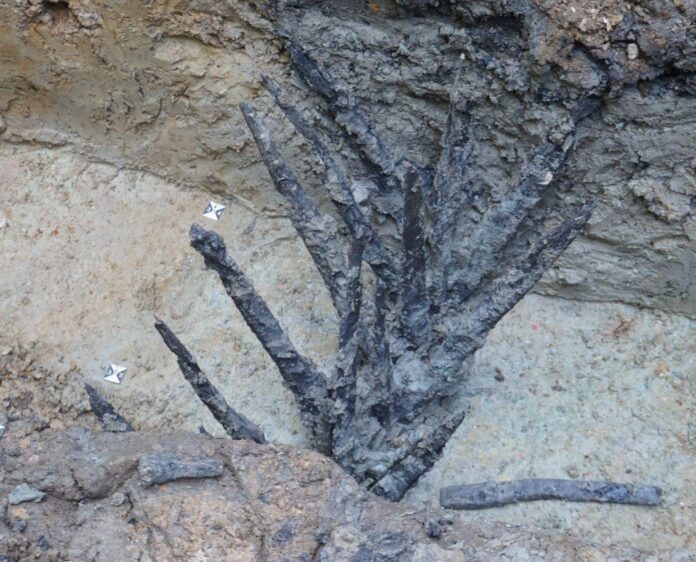For the first time, archaeologists have discovered wooden defenses surrounding an ancient Roman military base. The fence topped with sharpened wooden stakes, akin to today’s barbed wire, is the kind of fortification known to have existed from ancient writings—including by Caesar—but no surviving examples had previously been found.
The intimidating defense measures are located in what is now the town of Bad Ems in Rhineland-Palatinate, Germany. Excavations on the site began after a local hunter, Jürgen Eigenbrod, noticed faint markings on the ground in a field in 2016. The differences in color in sections of the grain, it turned out, were caused by the remnants of ditches dug by the Romans.
Using geomagnetic prospecting, archaeologists have since discovered evidence of no fewer than 40 towers at the site, as well as a smaller camp, on opposite sides of the valley. The area appears to have only served as a camp for a couple of years before burning down, reports Frankfurt’s Goethe University.
It appears that the ancient Romans were tunneling into the earth, searching for deposits of silver. At first, archaeologists believed that fire remains and melted slag were evidence that the Romans had set up a smelting works to process silver ore.

Hunter Jürgen Eigenbrod spotted these markings in a field in Germany, which turned out to be traces of an ancient Roman ditch. Photo by Hans-Joachim du Roi.
But the writings of the ancient historian Tacitus reveal that the Roman governor Curtius Rufus’s efforts to mine silver in the area failed in the year 47 A.D. Expecting untold riches, the Romans had set up a heavily fortified base manned by military troops—which explains the barbed wire-like defenses, meant to deter sudden raids.
Unfortunately for them, a rich vein of the precious metal would not be unearthed in the area until millennia later, during archaeological excavations in 1897. There was enough silver there that Romans could have continued mining operations for two centuries—if they had only kept digging.
The remains of the ancient fire, it would seem, came from a watch tower, not a profitable smelting works.

The ancient Romans erected a fence topped with these wooden spikes in a effort to defend a silver mining operation that ultimately ran dry. Photo by Frederic Auth.
These futile ancient efforts make for a fascinating story—Frederic Auth, the leader of the excavations since 2019, won first prize for his account of the history of the site at the 2022 Wiesbaden Science Slam.
Research and excavations are slated to continue, ledby Markus Scholz, a professor of archaeology and ancient Roman history of Roman at Goethe University; archaeologist Daniel Burger-Völlmecke, and Peter Henrich of the General Directorate for Cultural Heritage in Rhineland-Palatinate. Meanwhile, the ancient wooden spikes are now at the Römisch-Germanisches Zentralmuseum in Mainz.

























